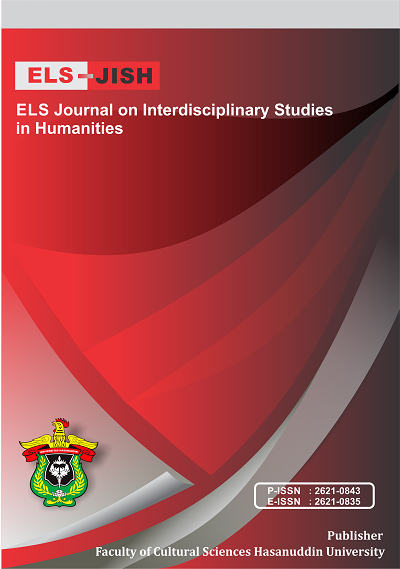Vocabulary Mastering of Hanyu Shuiping Kaoshi Level 3 Students of Chinese Language and Culture Study Program Hasanuddin University
DOI:
https://doi.org/10.34050/elsjish.v7i3.37181Keywords:
Hanyu Shuiping Kaoshi 3, Mandarin, Psycholinguistic Approach, Vocabulary MasteryAbstract
This research examines and contains a description of the mastery of Mandarin vocabulary at the level of Hanyu Shuiping Kaoshi 3 students of the Mandarin Language and Chinese Culture study program at Hasanuddin University using a psycholinguistic approach by taking a sample of 20 students from a total population of 40. The description regarding mastery of vocabulary is divided into two, namely mastery of receptive vocabulary and mastery of productive vocabulary by carrying out two types of tests, the first test is a written test which consists of six parts which all require abilities which include: knowledge, understanding and use of one character, a combination character characters that form words and vocabulary contained in a sentence based on a certain context or idea, then second test is an interview test to describe the factors that influence mastery of this vocabulary which divided into two, namely the internal factor which included the curiosity, certain positive activity, self-learning methods, and intrinsic and extrinsic motivation, therefore the external factor which included social environment and the availability of learning media. This research come to the conclusion of the vocabulary as essentially unmeasurable and was shown as the form of knowledge which going through mental processes, from a continuum stage of being able to receiving, absorbing and comprehend vocabulary towards a continuum stage of being able to use and producing vocabulary as known as the receptive knowledge to productive knowledge.Downloads
References
Carson, L., & Jiang, N. (2021). Offensive Words in Chinese Dialects. In An Anatomy of Chinese Offensive Words: A Lexical and Semantic Analysis (pp. 99-143). Cham: Springer International Publishing.
Chaer, A. (2007). Linguistik Umum. Jakarta: Rineka Cipta.
Cheng, J., & Matthews, J. (2018). The relationship between three measures of L2 vocabulary knowledge and L2 listening and reading. Language Testing, 35(1), 3-25.
Dalimunthe, L., & Haryadi, R. N. (2022). The Effect of Learning Methods and Vocabulary Mastery on English Speaking Ability. Lingua Educationist: International Journal of Language Education, 1(1), 1-7.
Djumambetova, G. (2023). Scientific-Theoretical Views On Terms And Terminology In Linguistics. Журнал иностранных языков и лингвистики, 5(5), 38-51.
Gureckis, T. M., & Markant, D. B. (2012). Self-directed learning: A cognitive and computational perspective. Perspectives on Psychological Science, 7(5), 464-481.
Hanafiah, W., Aswad, M., Sahib, H., Yassi, A. H., & Mousavi, M. S. (2022). Research Article The Impact of CALL on Vocabulary Learning, Speaking Skill, and Foreign Language Speaking Anxiety: The Case Study of Indonesian EFL Learners. Hindawi Education Research Internationa. https://doi.org/10.1155/2022/5500077
Hasnia, H., Andini, C., Tahir, M. D., Hunaeni, H., Zulfikariandi, Z., & Muslimin, M. T. (2022). The Ability of 1st Class Students of SMAN 11 Enrekang to Arrange Verbal and Nominal Sentences. ELS Journal on Interdisciplinary Studies in Humanities, 5(3), 539-550.
Jiang, L., Yu, M., & Li, L. (2013). Legacy: Panduan Persiapan HSK 3. PT Legacy Utama Kreasindo, Jakarta Selatan, Indonesia. Hlm 178-179
Mahdavi Zafarghandi, A., & Amini, S. (2019). The relationship between multiple intelligences and vocabulary learning strategies of intermediate EFL learners. Iranian Journal of English for Academic Purposes, 8(3), 65-76.
Nation, P. & Beglar, D. (2007) A vocabulary size test. The Language Teacher 31(7): 9-13. DOI: https://dx.doi.org/10.26686/wgtn.12552197.v1
Rahman, F., & Weda, S. (2019). Linguistic deviation and the rhetoric figures in Shakespeare’s selected plays. XLinguage" European Scientific Language Journal", 12(1), 37-52.
Ren, Y., Wyver, S., Xu Rattanasone, N., & Demuth, K. (2016). Social competence and language skills in Mandarin–English bilingual preschoolers: The moderation effect of emotion regulation. Early Education and Development, 27(3), 303-317.
Sun, H., & Verspoor, M. (2022). Mandarin vocabulary growth, teacher qualifications and teacher talk in child heritage language learners. International Journal of Bilingual Education and Bilingualism, 25(6), 1976-1991.
Tammasse, Jumraini, Rahman, F. (2019). Some difficulties in verbalizing English words and phrases: A case study of suspected dyslexic children. Asian EFL Journal Research Articles, 6(26), 73-85.
Thamrin, L. (2021). Mandarin Learning Strategy in Higher Education to Achieve the New Hanyu Shuiping Kaoshi Standard at Level 3. Journal of Education Research and Evaluation, 5(3), 480-488.
Schmitt, N., Schmitt, D., & Clapham, C. (2001). Developing and exploring the behaviour of two new versions of the Vocabulary Levels Test. Language testing, 18(1), 55-88.
Hwat, T. T. (2010). Bahasa Mandarin Untuk Pemula I. Perpustakaan Nasional RI: Niaga Swadaya.
Kai, Z. (2006). Hanyu Shuiping Kaoshi (HSK) Yanjiu. Shangwu Yinshuguan, Beijing, China.
Vashti, B., Thamrin, L., & Veronica, T. (2022). Mastery Ability of Chinese Proverbs in Mandarin Language Education Study Program Students. Jurnal Mantik, 6(1), 629-638.
Weda, S., Atmowardoyo, H., Rahman, F., & Sakti, A. E. F. (2021). Linguistic aspects in intercultural communication (IC) practices at a higher education institution in Indonesia. Eroupean Language Scientific Journal, 14, 2-6.
Weda, S., Atmowardoyo, H., Rahman, F., Said, M. M., & Sakti, A. E. F. (2021). Factors affecting students’ willingness to communicate in EFL classroom at higher institution in Indonesia. International Journal of Instruction, 14(2), 719-734.
Zhao, P., & Ji, X. (2018). Validation of the Mandarin version of the Vocabulary Size Test. RELC Journal, 49(3), 308-321.
Zhang, P., & Graham, S. (2020). Learning vocabulary through listening: The role of vocabulary knowledge and listening proficiency. Language Learning, 70(4), 1017-1053.
Zhang, S., & Zhang, X. (2022). The relationship between vocabulary knowledge and L2 reading/listening comprehension: A meta-analysis. Language Teaching Research, 26(4), 696-725.
Downloads
Published
How to Cite
Issue
Section
License
Copyright (c) 2024 Yuspani Amelia J, Wan Wen Bin, Fakhriawan Fathu Rahman

This work is licensed under a Creative Commons Attribution-ShareAlike 4.0 International License.

















